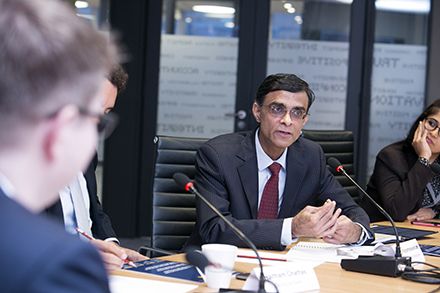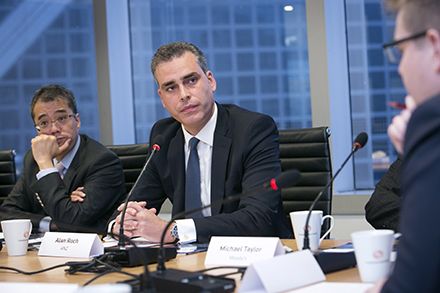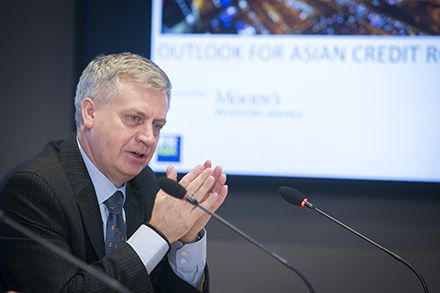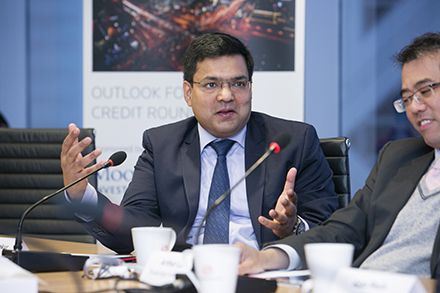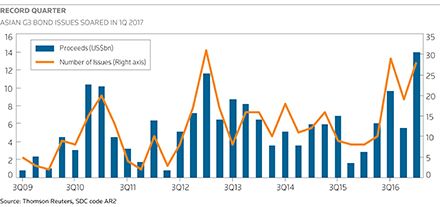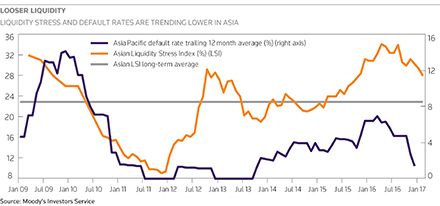Of course if you understand the policy dynamic it will be easier for you to cherry pick the best sectors in the near to medium term. In my view even those LGFVs that may not have a viable business model should be OK in the near time because the government needs to open up the market for this sector.
IFR ASIA: Beyond China, do we see big opportunities in other markets at the moment?
HAITHAM GHATTAS, DEUTSCHE BANK: We continue to be very, very constructive on the general expansion of the Asian debt capital markets. India in 2014 had a big breakout year for high yield, and we’ve seen further developments in that market over the last 12 months. I think that’s going to be a continued area for strong growth. You’ve seen a few deals this year that have been well received by the market, both from repeat borrows as well as first-time issuers.
We remain very constructive on India as a source of new high-yield borrowers and we think it’s a natural evolution that more and more of them will come into the international markets.
Just tying back to an earlier question on default rates, we’ve also got to bear in mind just where we are in the default cycle.
There’s a reason why the market is willing to support deals at the levels that’s we’re seeing. If you look back over the last 12 months, you can pick 8 to 10 high-yield names that were trading in the 30s and 40s. Probably 7 of those today are now trading at par and only one is in default.
For all the concerns and the risks that we all acknowledge, actual default rates have been very, very low. To some degree it’s a function of the structure of the markets here in Asia, with very strong domestic bank liquidity, domestic bond market liquidity. The ability for companies potentially to raise equity or bring in external funding is very supportive compared to other developed markets, where individual companies are more dependent on one source of financing.
WILLIAM FUNG, AMTD: I think Haitham’s point is interesting. As a disclaimer, we invest very little in the distressed space, but we’re getting a sense that the onshore banks right now have a lot of liquidity and that’s why we’re not seeing a lot of defaults, especially in China.
They may be willing to bail them borrowers because they were asked to support an important source of GDP or a big taxpayer. Or they have a very good relationship, or very good assets so banks are willing to lend.
I think that is a two-edged sword, because one concern that we have is the availability of leverage. I agree that at the corporate level leverage is actually decent and healthy. But if you look at the market as a whole, we are seeing more and more investors using leverage just because Chinese banks and foreign banks are developing this business. There’s a lot of structured products being put into the market. The Chinese banks are very active in this space both from a lending perspective and also on the receiving end of using this leverage.
At the moment obviously the banks are willing to lend. My concern is what happens when they are unwilling or unable to rollover this leverage when the time comes, and then people are forced to sell.
There was a moment last year when we saw Chinese AT1s dip a little because we heard a few big leveraged notes were not rolled over and then they were forced out. After a few days people started picking them up in secondaries and now they’re trading very well.
My concern is that there is a lot of leverage in the system. If the yields on low Single Bs are only at 6%–7%, people chasing double digit returns need to lever up. What happens if this leverage game starts to end? Then we’ll see a crashing of the market for sure.
HAITHAM GHATTAS, DEUTSCHE BANK: In some ways that raises the point around how issuers place notes into the market. Over the lifespan of these companies, it’s important for them to cultivate deep institutional relationships – whether that is within Asia or globally through 144A issuance. Ultimately that is a form of protection for the issuer because they become much less reliant on sources of capital which are more dependent on leverage and perhaps are more likely to come in and out of the market.
To my mind, while we continue to be very encouraged by the overall deepening of the Asian liquidity pool, what is most encouraging is that the core institutional buyer base is growing very rapidly. I think those issuers that really spend the time with that core investor base, both at the time of issuance and in the future, will ultimately be in a stronger position in periods of market turbulence.
IFR ASIA: Do issuers now deliberately under-allocate these more leveraged funds? Dilip mentioned private bank allocations have gone down.
AVINASH THAKUR, BARCLAYS: I think it’s a deliberate strategy. We haven’t seen any reduction in interest from the private banks in the transactions that we’ve been managing. There is a very focused approach from the issuers to look at investors who can stay with them in the long term.
They’re spending time with investors much more than they did before. You see companies going out to talk about their credit with the right investors. If you look at the quality real money, the way we would define it, the allocation has been going up steadily over time.
ALAN ROCH, ANZ: I’d agree with that. I think for any new issue there’s a right mix of investors. A long-term relationship with fund managers and institutional money is beneficial to issuers, and I think they have that at the forefront of their mind when they look at allocations.
We’re seeing more and more interest from these private banks in bond deals, whether it’s local currency markets or dollars, but there is merit for an issuer to cultivate those long term relationships with institutional buyers.
IFR ASIA: Then the follow up is then does that change the way that deals get brought to the market at all? Are we going to see less of these term sheets with joint lead manager interest at the bottom of the page?
ALAN ROCH, ANZ: I think there are two answers to that. One of course is around who ultimately gets allocated bonds. Also the reason you’re seeing this statement more now than before is because the disclosure requirement in terms of the composition of the order book is different today than it was in the past.
It’s not necessarily a sign that we’re seeing more JLM interest in deals today than before. It’s just that today you’ve got to be very upfront in acknowledging it.
IFR ASIA: Arthur, from the investor side, do you get the disclosures around new issues that you need?
ARTHUR LAU, PINEBRIDGE: Actually what I really need is more time. The market dynamic that we’re describing is so strong, and I often find I just don’t have the time to understand the credit a little bit better.
Of course in terms of documentation, you know what to expect in the prospectus. For high-yield issues we would love to spend a little bit more time to understand the structure. In the old days I did get a chance to bargain with the bankers around covenants, but now it seems there is no time because all the buyers are chasing this paper. I think that process could be improved somewhat, especially in some hot deals. I remember one situation where instead of a 1-on-1 meeting we got 14 on 1, with 14 investors facing the issuer. It’s not unusual in my field.
I don’t know whether I’m allowed to ask this, but can we have a little bit more advanced notice about roadshows? Or would the issuer be kind enough to spend a little bit more time with us? Spend one more day in Hong Kong or in Singapore, not just half a day in both.
In some deals we are not able to participate in a much bigger way because we were not able to get the right answer to some of our questions. I can give you an example. On one of the recent investment grade Malaysian deals, we were able to speak to the issuer in a private session after the roadshow. We actually put in a very good order because we were able to clarify some of the questions that we wanted to address.
I think I can speak on behalf of some of my peers on the investor side. They have a similar challenge. They would love to participate but they have spent too little time with the issuer.
IFR ASIA: I mean actually we don’t need to go to London on these roadshows anymore. We can do another day in Hong Kong.
AVINASH THAKUR, BARCLAYS: Our objective – and I’m sure other bankers here would agree with me – is always to try and get the issuers to spend time with investors. For first-time issuers we do investor marketing well ahead of any issuance.
We are definitely very keen for investors to get their time to look at the credit. There are some issues with that. One is, unlike a few years ago, these exercises don’t always achieve much because you don’t get the feedback you would get in the past. Maybe it’s a function of the volume that we’re seeing in the market today, but the question is whether you really need to add to the issuance timeline.
Another issue with any marketing or any credit explanation ahead of an issuance is that you can’t involve too many investors. The regulations are much well defined today and you have to do wall crossing of investors before you disclose information. So you have to depend on a very small set of investors and that in some ways defeats the whole purpose because you’re getting feedback from very few investors.
The objective is very clear: we want investors to get more time, but there are issues to deal with when you try to do that.
HAITHAM GHATTAS, DEUTSCHE BANK: I completely understand where you’re coming from, because when I see roadshow schedules these days, the small group meetings are no longer really small groups at all!
In a way it’s a function of how the Asian investor base has developed. We have seen a proliferation of funds that were managing perhaps US$200m–$300m two or three years ago and would have been very happy coming to a luncheon, and suddenly they’re running US$1bn.
It’s a balance. The banks really do want to give investors time to do a deep dive into the credit. On the other hand you’ve got limited management time and a tight market window so we have to prioritise. I think it’s going to continue to be a struggle just because there are so many market participants.
In the US or European market the smaller investors are typically quite comfortable listening to the management team at a lunch. In Asia, we’ve evolved in such a way that now everybody needs to be in a group meeting and it’s become a little dysfunctional.
I think there’s room for improvement there. Ultimately, I think again the overriding positive is the depth and the variety of investors who want to actively participate in these transactions.
ALAN ROCH, ANZ: From the bank standpoint, we have a responsibility to the issuer, and the issuer’s incentive is obviously to announce a transaction and price as soon as possible. At the same time we have a duty of care to investors and to making sure they have the proper time to do their due diligence.
I’m of the view that there are some transactions where we should spend a bit more time on the road. You mentioned a few of these high yields. In some of these specific instances the company was very quick in dealing with questions and that translated into a super-high hit ratio between investors at the roadshow and those placing orders.
In the meantime, there are some regular issuers that still insist on doing roadshows and, quite frankly, these are no longer required. People show up for them and it’s more of a distraction than anything else. So perhaps there should be a bit more discipline on the banks’ side on spending more time with those projects that really require it.
ARTHUR LAU, PINEBRIDGE: I absolutely agree. It’s a difficult balance, and I fully appreciate that.
It’s not just on the meeting side, but it’s also the time we get with the information – the roadshow prospectus. It’s not common, but we have seen some issuers announcing in the morning and closing the deal that day. That is pretty challenging for us in terms of cracking the credit.
IFR ASIA: Going back to credit and the broader outlook, Michael, what concerns you and what trends do you see around the region?
MICHAEL TAYLOR, MOODY’S: I deliberately didn’t mention China in my intro because I knew we would get around to talking about it. As we’ve been saying for a couple of years now, we were not in the school that expected a hard landing. We also didn’t expect a financial crisis, and I think that’s still fairly unlikely.
There are really two things that concern us. One is the capital outflows issue, because the stronger those capital outflows are the more constrained the central bank becomes in terms of monetary policy. We’ve talked already about the tightening liquidity conditions onshore, and the market indicators were very clear even before the PBOC signalled its recent change in stance. Tighter onshore liquidity does raise the likelihood that defaults will happen in future. So that’s one thing to focus on.
The other one is reform momentum. We’re not really seeing that much progress on reform at the moment, and I suspect that’s going to remain the case until certainly after the party congress later this year. While the lack of reform momentum doesn’t sort of point to a sudden shock, it does suggest that the growth rate is gradually trending down and that the inefficiencies in the economy are simply going to grow.
IFR ASIA: When you talk about reform you mean individual companies being reformed, or you mean more broadly a shift in the market?
MICHAEL TAYLOR, MOODY’S: More broadly. It’s the 330 separate items that were outlined in the decision that came out of the Third Plenum in November 2013 around rebalancing the economy towards the consumer and away from this past dependence on investment – and infrastructure investment in particular. It’s happening, but it’s happening quite slowly.
We’re not expecting any kind of shock emanating from China. It’s more a gradual deterioration in credit quality over time, unless reform really starts to pick up to address some of the economy’s underlying structural challenges.
In India, we’ve had a positive outlook on the sovereign for several years now, and we recently affirmed the rating at Baa3 and kept the positive outlook in place. India has made a number of positive steps in recent years. There’s been an improvement in budget and fiscal discipline. India certainly gained from the collapse in the oil price and that has helped the balance of payments. Plus we’ve seen some progress in reform under Modi, particularly with the GST, which we saw as a very important development, and the RBI has established a great deal of credibility.
There are still a few issues hanging around. I think the two main ones are the state banks, where there is a need for substantial additional capital. Then there are certainly some parts of the corporate sector which are very highly levered.
More broadly around the region, our view is the credit fundamentals are still strong, but they are likely to be challenged. Again to pick up on something that Dilip mentioned, leverage around the region has certainly risen. If you compare it to 2008, we’ve seen a very substantial rise.
The interesting thing is when we look at the Moody’s rated portfolio, although there has been a bit of deterioration in things like debt to Ebitda, we don’t really see the kind of very substantial rise in leverage that would expect from the aggregate numbers.
That comes back to your point, Arthur, that it’s still a bank-dominated system. A lot of the rise in leverage that we’ve seen around the region has been intermediated through banking systems rather than through the debt markets. On a long-term view, there is huge development potential in the debt markets around the region.
IFR ASIA: This is one of the reasons I mentioned India, because that’s definitely happening in the local market. Is that going to be a driver in the international capital markets?
DILIP PARAMESWARAN, ASIA INVESTMENT ADVISORS: India has puzzled me a little bit for a while. At the beginning of last year, I was on a different panel, and people said, “Oh, we have high hopes for this flood of issuance from India”. It is the same every year.
Yes, of course last year there were a few new issuers: a couple of infrastructure companies, Motherson Sumi, and so on. But is it proportionate to the expectations that market participants have? Is it proportionate to the size of the economy and its development potential? I don’t think so.
I have asked myself if regulations are holding back issuers who might otherwise have accessed international markets. Is it also a reflection of the slow start to Modi’s ‘Make in India’ policy? I don’t know what’s holding that market back. But every year people have these high hopes.
ALAN ROCH, ANZ: I’m entirely with this. This market is often characterised with high expectations. Perhaps a very well-functioning local currency market is one of the reasons. There were a few new gems last year, and on our side there are a few more that are going to come out, but they’re few and far between in comparison to other markets.
It’s one of the reasons why India spreads are actually very tight. India does trade very tight for its rating band. As much as we’d like to encourage more offshore issuance, I’m not sure this year is going to be much different than previous years.
DILIP PARAMESWARAN, ASIA INVESTMENT ADVISORS: The banks used to be steady issuers from India, and I sense a little bit of a slowdown there. Everybody is aware of the bad-loan problems with the banks, and they are themselves trying to sort out the mess.
AVINASH THAKUR, BARCLAYS: The real driver in India will have to be growth and capital expenditure as we restart the investment cycle. That’s not yet happened. The last few years have been very slow. The banks and the corporates don’t really have a need for capital right now.
We are starting to see that change now. You will see the cycle turning in India because of the reforms that Modi has brought in. It’s taken time, but we are constructive on India and we expect more issuance.
IFR ASIA: It should be a big market for bank capital, shouldn’t it? Again, it hasn’t really taken off yet.
ALAN ROCH, ANZ: From my perspective you need three things to have more capital issuance. You need asset growth, and across the region we don’t see as much as we had expected. Actually, I think a lot of banks raised capital with the expectation that assets were going to grow at a higher pace.
Then you need conformity with Basel III requirements. Taking out India, there’s no real catalyst there. The third is redemptions, and I think that actually could be a driver this year. We have US$6bn of bank capital bonds in US dollars maturing across China, Hong Kong, India, Singapore. I think that could spur some transactions perhaps more in Tier 2 than in AT1.
Perhaps what could drive this is from a regulation standpoint is IFRS9, which means that you need to take into account capital as a buffer for expected losses from NPLs. Bar that and bar redemptions, it’s difficult to find a driver for significant issuance.
HAITHAM GHATTAS, DEUTSCHE BANK: Having said that, issuance on the senior side in the various forms and various currencies has grown and continues to be a bigger and bigger part of the market. Year to date close to 50% of all Asia G3 issuance is from FIG, and it’s up about 150% year on year. That is obviously very heavily weighted to the large Chinese entities and their various branches that are in the market week in week out. I agree with Alan there’s potential for more capital issuance but I think the senior side is just becoming more and more important as a driver of market volumes.
IFR ASIA: Before we finish I want to ask everyone what they see coming up for the rest of this year. William, you can give us the first prediction. What is the most exciting opportunity in Asian credit right now?
WILLIAM FUNG, AMTD: Our investors are more yield-driven than anything else, and we’re quite bullish on high yield this year. I think for the investment-grade side obviously the rates volatility is going to be the greatest performance issue there. That’s going to be challenging.
I’m quite surprised that we haven’t talked about Trump for more than one minute. Normally half of the meeting is about Trump! From what he says to what is implemented there’s still a lot of uncertainty. Is he going to move the market as he did before? I guess people have doubts now.
We’re still quite bullish on Asian high yield, and obviously there are still very good deals coming from investment-grade side. We talked about the fixed-for-life structure, which is fairly aggressive, but we’re still quite keen on some of the more investor-friendly perpetual. If I were to sum it up, this year we’re still quite favourable on yield products.
HAITHAM GHATTAS, DEUTSCHE BANK: To take a different perspective, one area that’s very interesting this year is the commodity sector. If you go back 12 months we were in the depths of despair and there was a huge amount of stress – not just here in Asia but globally. There’s been a phenomenal turnaround in the last 12 months across coal, oil, iron ore, all kinds of commodity markets. If we continue to see price rises and further signs of greater global growth you will see a number of issuers who’ve simply been unable to access markets coming through. You’ve already seen one or two names in 2017, and this is a trend we expect to continue and will certainly impact issuance this year.
DILIP PARAMESWARAN, ASIA INVESTMENT ADVISORS: I think I differ from William’s view on investment grade. Nobody is going to be surprised by three rate increases in the US this year. The 10-year rate might reach say 3% or so, but it won’t be a shock. IG spreads I think are going to be flat, but high yield spreads are on their way up by 50bp–75bp on average. For the last several years high yield has outperformed IG, and it will do so again this year but by a much smaller margin.
Given that it’s not going to outperform as much as it used to, then on a risk-adjusted basis I’m not sure high yield is the place to be. Within high-yield, there might still be good investments and bad ones, but my view is on average.
We are looking at overall Asia credit producing a total return of 2% to 3% for the year. High yield is going to be a little bit higher, maybe 4% or 5%. On a risk-adjusted basis, IG is more attractive than HY.
AVINASH THAKUR, BARCLAYS: I think it’s going to be a year of tight pricing. We’re seeing benign markets, and everyone is going towards the more esoteric or more risky stuff. So I’m sure we’ll see growth in high yield. It will play out in cyclical industries like commodities getting more attention in the market. It’ll play out in more aggressive structures. You’ll see more fixed-for-life perps, hybrids coming back, bank capital too. On the high grade side you will see issuers going into very long tenors. It’s going to be all about yield this year.
I don’t see anything on the horizon which makes me feel that rates are headed up any time soon. Even if you see three rate hikes, our view on the 10-year Treasury at the end of the year is not very different to where it is today.
ARTHUR LAU, PINEBRIDGE: I actually have quite low visibility on how the market will play out given all the political uncertainty in the US or in China. Of course, we can still find good opportunities selectively, but on a broad basis Asia is not cheap, so we are increasingly looking outside Asia. I do sense a little bit of complacency in the market given that credit spreads are very tight and the cushion is very thin.
My current thinking is this complacency could create some volatility, but the hunger for yield hasn’t really changed. That could be a buying opportunity. At least in the first half what I see is more of a momentum trade, rather than a big structural shift. I think any volatility could come in the latter part of this year, based on how many times rates increase, and how fast. As I mentioned in the opening, the one big macro factor that worries me is inflation, and it seems that prices are rising if you look at China and India.
So we are expecting a more volatile second half. Then once we have a little bit more understanding about Trump then 2018 will be a little bit more predictable. That’s my current prediction.
IFR ASIA: Okay, let’s get through this year first then. Alan?
ALAN ROCH, ANZ: I think duration is going to be a theme. I share the view of Avinash in terms of rates. You’re going to have a few hikes, but few are seeing the 10-year massively different at the end of this year. That could change the duration weighting for Asia. There’s very little long-term supply, and I think that will compound interest in longer-dated transactions.
In bank capital, Tier 1 has got very expensive, and Tier 2 was a forgotten child last year. Some investors are really starting to hone in on those differentials and we are seeing Tier 2 performing quite well. I think that will continue.
I do share an optimistic outlook for high yield as well. I think this year is going to be a risk-on year, at least as far as we can see. I don’t know how many fixed-for-life perpetuals we are going to see, but definitely I’d expect strong corporate issuers to continue issuing high yields products.
IFR ASIA: Michael, you have opportunity to wrap it all up for us.
MICHAEL TAYLOR, MOODY’S: I agree that the first half of this year is unlikely to see any major downside. I think volatility will become more of an issue as we go through the year.
From a China perspective I think there’s going to be a great focus on maintaining stability until the party congress, which will probably be sometime in October or November. That means two things. First of all reforms will progress relatively slowly, and I don’t think we’re going to see major moves in the renminbi or any change to the capital controls for a while longer.
I think any shocks are more likely to originate from outside the region than inside. It’s things like the market maybe getting a little bit complacent about the trajectory of US interest rates, or events in Europe that will spill over to Asia. It seems as though it’s not within the region that we need to be concerned about at the moment. It’s more what might hit us from outside.
IFR ASIA: Gentlemen, thank you very much for your time.
To view all special report articles please click here and to see the digital version of this report please click here.
To purchase printed copies or a PDF of this report, please email gloria.balbastro@thomsonreuters.com.
